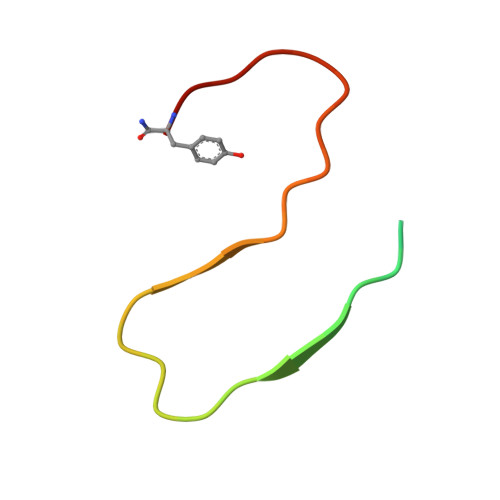Improving cryo-EM grids for amyloid fibrils using interface-active solutions and spectator proteins.
Valli, D., Ooi, S.A., Scattolini, G., Chaudhary, H., Tietze, A.A., Maj, M.(2024) Biophys J 123: 718-729
- PubMed: 38368506
- DOI: https://doi.org/10.1016/j.bpj.2024.02.009
- Primary Citation of Related Structures:
8R4I - PubMed Abstract:
Preparation of cryoelectron microscopy (cryo-EM) grids for imaging of amyloid fibrils is notoriously challenging. The human islet amyloid polypeptide (hIAPP) serves as a notable example, as the majority of reported structures have relied on the use of nonphysiological pH buffers, N-terminal tags, and seeding. This highlights the need for more efficient, reproducible methodologies that can elucidate amyloid fibril structures formed under diverse conditions. In this work, we demonstrate that the distribution of fibrils on cryo-EM grids is predominantly determined by the solution composition, which is critical for the stability of thin vitreous ice films. We discover that, among physiological pH buffers, HEPES uniquely enhances the distribution of fibrils on cryo-EM grids and improves the stability of ice layers. This improvement is attributed to direct interactions between HEPES molecules and hIAPP, effectively minimizing the tendency of hIAPP to form dense clusters in solutions and preventing ice nucleation. Furthermore, we provide additional support for the idea that denatured protein monolayers forming at the interface are also capable of eliciting a surfactant-like effect, leading to improved particle coverage. This phenomenon is illustrated by the addition of nonamyloidogenic rat IAPP (rIAPP) to a solution of preaggregated hIAPP just before the freezing process. The resultant grids, supplemented with this "spectator protein", exhibit notably enhanced coverage and improved ice quality. Unlike conventional surfactants, rIAPP is additionally capable of disentangling the dense clusters formed by hIAPP. By applying the proposed strategies, we have resolved the structure of the dominant hIAPP polymorph, formed in vitro at pH 7.4, to a final resolution of 4 Å. The advances in grid preparation presented in this work hold significant promise for enabling structural determination of amyloid proteins which are particularly resistant to conventional grid preparation techniques.
- Department of Chemistry - Ångström Laboratory, Uppsala University, Uppsala, Sweden.
Organizational Affiliation:
















